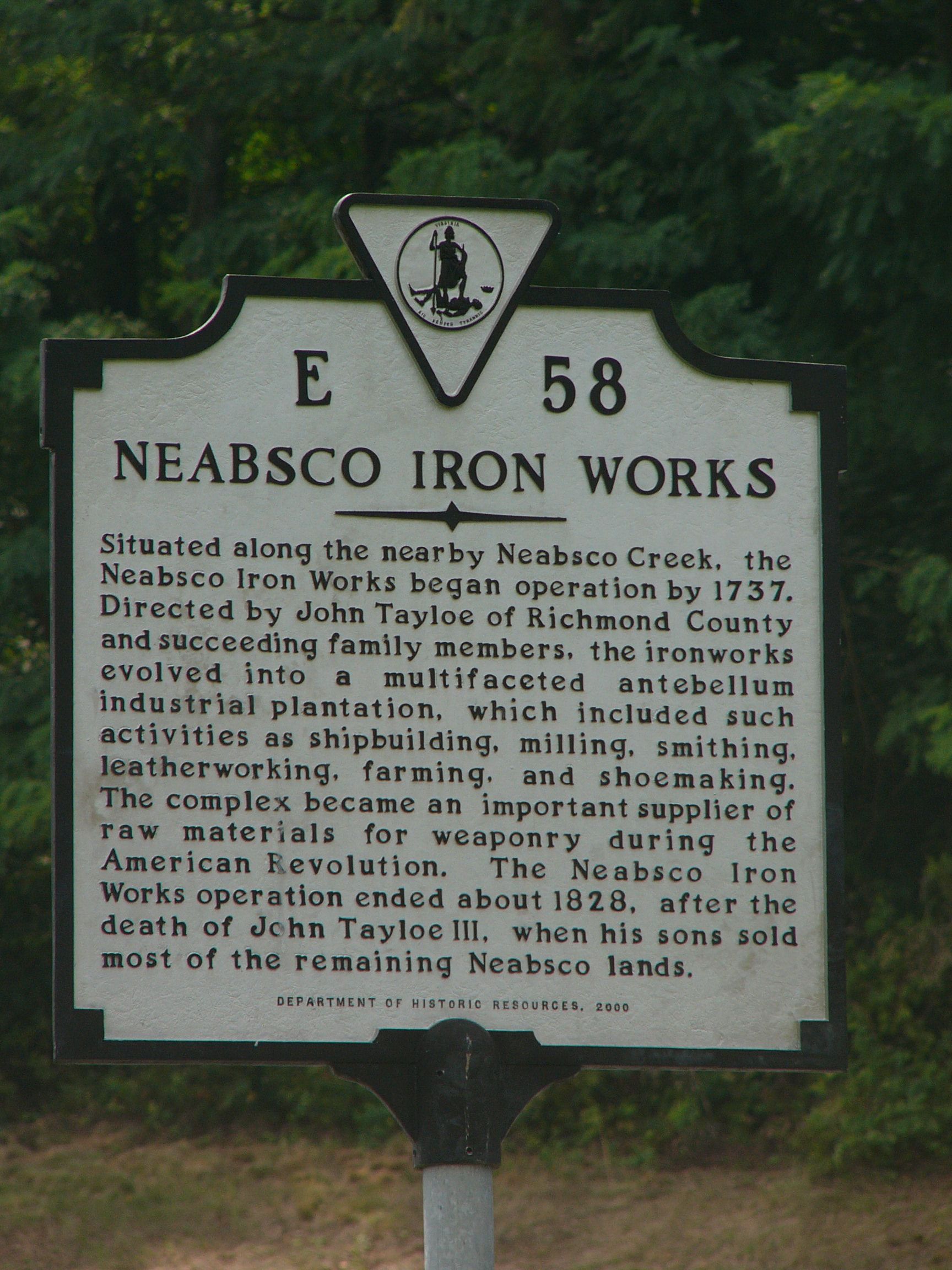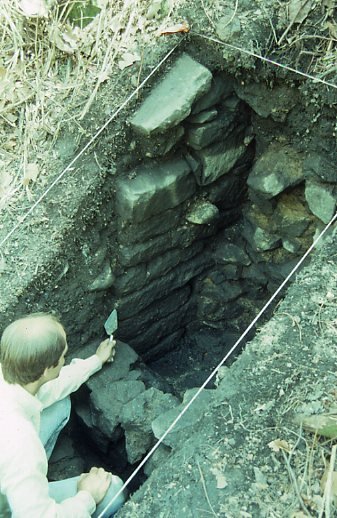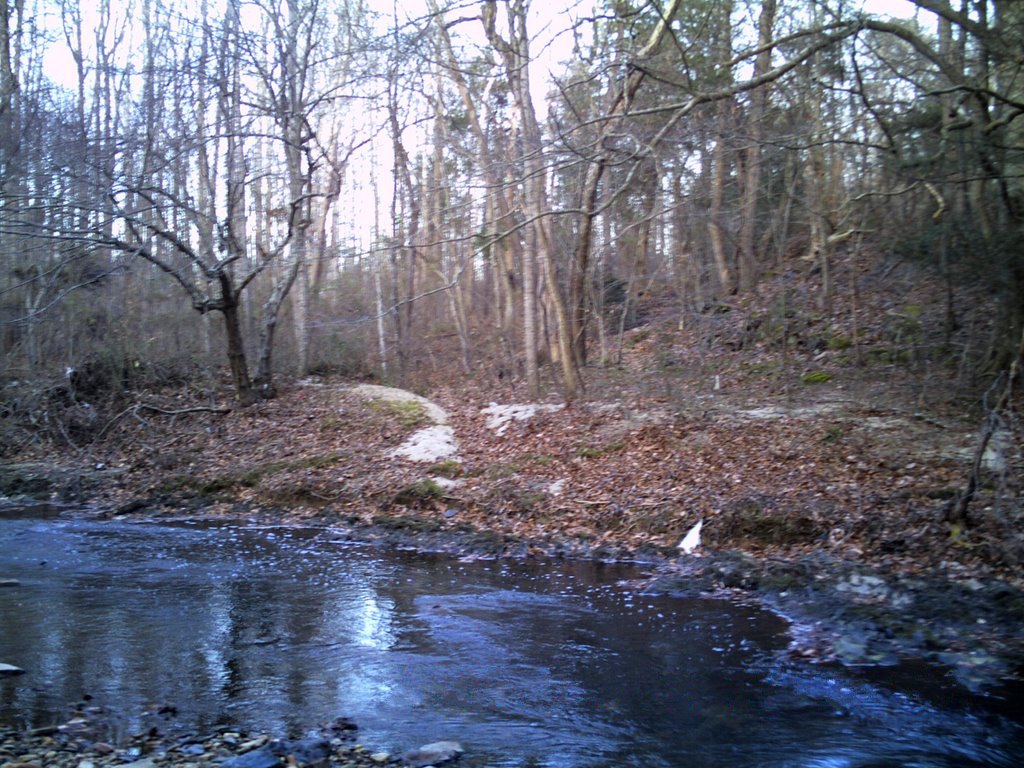Neabsco Iron Works on:
[Wikipedia]
[Google]
[Amazon]
 The Neabsco Iron Works (alternates: Neabsco Company; Neabsco Iron Foundry) was located in
The Neabsco Iron Works (alternates: Neabsco Company; Neabsco Iron Foundry) was located in
 The Neabsco Iron Works were the first iron works in northern Virginia. Established around 1737, By
The Neabsco Iron Works were the first iron works in northern Virginia. Established around 1737, By
 Today little remains of the Neabsco Iron works; the forest has reclaimed the slopes. There are some pits, some stones of the furnaces and foundations of buildings. There are also intact service roads and road remnants, eroded water races. Slag from Iron blasting litter the terraced work areas on the slope above the two furnace locations. The Creek and Neabsco Harbor are now silted in due to deforesting for tobacco farming and rampant development upstream. As a reference, the Neabsco Industrial plantation, contained an approximate area from South at Powell's Creek to North at the
Today little remains of the Neabsco Iron works; the forest has reclaimed the slopes. There are some pits, some stones of the furnaces and foundations of buildings. There are also intact service roads and road remnants, eroded water races. Slag from Iron blasting litter the terraced work areas on the slope above the two furnace locations. The Creek and Neabsco Harbor are now silted in due to deforesting for tobacco farming and rampant development upstream. As a reference, the Neabsco Industrial plantation, contained an approximate area from South at Powell's Creek to North at the
File:Furnace pit.jpg, Stones of furnace one, long gone, viewed from creek side
File:Location of Neabsco Furnace with landmarks.jpg, Location of Neabsco Furnace with landmarks.
File:Roaring Run Furnace 3.jpg, Intact iron furnace At Roaring Run similar to Neabsco's.
File:Roaring Run Furnace 2.jpg, Intact Roaring Run Furnace. Note person for Scale. These colonial furnaces were huge
File:PITABOVE.jpg, Furnace two remnants, viewed from work terrace above
File:CREEKDIG.jpg, Large dig next to Neabsco Creek, possibly for a Mill works
File:Service Road remnants.jpg, Section of surviving Neabsco service road
File:Elizabeth Furnace Pig iron.jpg, How pig iron is made, in a colonial blast furnace, from a display at
 The Neabsco Iron Works (alternates: Neabsco Company; Neabsco Iron Foundry) was located in
The Neabsco Iron Works (alternates: Neabsco Company; Neabsco Iron Foundry) was located in Woodbridge, Virginia
Woodbridge is a census-designated place (CDP) in Prince William County, Virginia, United States, located south of Washington, D.C.. Bounded by the Occoquan and Potomac rivers, Woodbridge had 44,668 residents at the 2020 census.
Woodbridge o ...
, US. It was situated on by the Neabsco Creek
Neabsco Creek is a U.S. Geological Survey. National Hydrography Dataset high-resolution flowline dataThe National Map accessed August 15, 2011 tributary of the lower tidal segment of the Potomac River in eastern Prince William County, Virginia. T ...
.
After abandoning the Bristol Iron Works The Bristol Iron Works, near to the J-64 Virginia Historical Marker on Route 3 below Rollins Fork, was located along the Rappahannock River across from Horse Head Point. The works were overseen by John King and Company from Bristol, England and e ...
, John Tayloe I
Col. John Tayloe I (February 15, 1688November 15, 1747) was one of the richest plantation owners and businessmen in Virginia for his generation. Considered to be the chief architect of the family fortune, he was known as the "Hon. Colonel of the Ol ...
established the Neabsco Iron Foundry around 1737. The business became a multifaceted antebellum industrial plantation. Its activities included farming, leatherworking, milling, shipbuilding, shoemaking, and smithing, as well as supplying raw materials used as weaponry during the American Revolution
The American Revolution was an ideological and political revolution that occurred in British America between 1765 and 1791. The Americans in the Thirteen Colonies formed independent states that defeated the British in the American Revolut ...
. The business grew and expanded with his son, John Tayloe II
Colonel John Tayloe II (28 May 172118 April 1779) was a planter and politician, among the richest planters in colonial Virginia. He served in public office including the Virginia Governor's Council, also known as the Virginia Council of State.
...
, when, in 1756, he bought the Occoquan Ironworks Occoquan may refer to:
*Occoquan, Virginia
*Occoquan River
*Occoquan Bay National Wildlife Refuge
The Occoquan Bay National Wildlife Refuge is a National Wildlife Refuge located where the Occoquan River meets the Potomac River in Woodbridge, Vir ...
company, eventually running it as one business with the Neabsco.
History
 The Neabsco Iron Works were the first iron works in northern Virginia. Established around 1737, By
The Neabsco Iron Works were the first iron works in northern Virginia. Established around 1737, By John Tayloe I
Col. John Tayloe I (February 15, 1688November 15, 1747) was one of the richest plantation owners and businessmen in Virginia for his generation. Considered to be the chief architect of the family fortune, he was known as the "Hon. Colonel of the Ol ...
, a wealthy Virginia land owner, who owned several iron works. His son, John Tayloe II
Colonel John Tayloe II (28 May 172118 April 1779) was a planter and politician, among the richest planters in colonial Virginia. He served in public office including the Virginia Governor's Council, also known as the Virginia Council of State.
...
, became a partner in the nearby Occoquan Iron Works. Thomas Jefferson
Thomas Jefferson (April 13, 1743 – July 4, 1826) was an American statesman, diplomat, lawyer, architect, philosopher, and Founding Fathers of the United States, Founding Father who served as the third president of the United States from 18 ...
wrote in his book, Notes on the State of Virginia
''Notes on the State of Virginia'' (1785) is a book written by the American statesman, philosopher, and planter Thomas Jefferson. He completed the first version in 1781 and updated and enlarged the book in 1782 and 1783. It originated in Jeffers ...
, of Iron being forged at Neabsco "from pigs imported from Maryland; and Taylor's forge on Neapsco of Patowmac, works in the same way, but to what extent I am not informed."
The site offered 3–5000 acres of trees for firewood mostly to make charcoal to heat the blast furnaces. Charcoal
Charcoal is a lightweight black carbon residue produced by strongly heating wood (or other animal and plant materials) in minimal oxygen to remove all water and volatile constituents. In the traditional version of this pyrolysis process, cal ...
making, in itself, was as dedicated, expert and involved a process, as Iron blasting. The site also offered large deposits of iron ore. A creek with plentiful running water and adequate fall for water works to operate bellows and mills. As the site is at the cusp of the fall line and coastal plain, the creek was deep enough in part, to transfer pig iron
Pig iron, also known as crude iron, is an intermediate product of the iron industry in the production of steel which is obtained by smelting iron ore in a blast furnace. Pig iron has a high carbon content, typically 3.8–4.7%, along with silic ...
(recently blasted raw unworked iron) by boat less than a mile downstream to Neabsco Harbor on the Potomac River
The Potomac River () drains the Mid-Atlantic United States, flowing from the Potomac Highlands into Chesapeake Bay. It is long,U.S. Geological Survey. National Hydrography Dataset high-resolution flowline dataThe National Map. Retrieved Augus ...
. There the iron could be transferred to ocean-going vessels. It was also close to a major road, the Kings Highway. Because much of the ore, on site, turned out to be of low quality, ore was boated in from Tayloe's mines in Maryland
Maryland ( ) is a state in the Mid-Atlantic region of the United States. It shares borders with Virginia, West Virginia, and the District of Columbia to its south and west; Pennsylvania to its north; and Delaware and the Atlantic Ocean to ...
. Most of the labor was provided by slaves and indentured servants.
The works shut down around 1820 as it could no longer compete with cheaper iron being produced in the North and had exhausted its supply of abundant, available fire wood. It is estimated that it took one half an acre of firewood to produce one ton of pig iron.
Current condition of site
 Today little remains of the Neabsco Iron works; the forest has reclaimed the slopes. There are some pits, some stones of the furnaces and foundations of buildings. There are also intact service roads and road remnants, eroded water races. Slag from Iron blasting litter the terraced work areas on the slope above the two furnace locations. The Creek and Neabsco Harbor are now silted in due to deforesting for tobacco farming and rampant development upstream. As a reference, the Neabsco Industrial plantation, contained an approximate area from South at Powell's Creek to North at the
Today little remains of the Neabsco Iron works; the forest has reclaimed the slopes. There are some pits, some stones of the furnaces and foundations of buildings. There are also intact service roads and road remnants, eroded water races. Slag from Iron blasting litter the terraced work areas on the slope above the two furnace locations. The Creek and Neabsco Harbor are now silted in due to deforesting for tobacco farming and rampant development upstream. As a reference, the Neabsco Industrial plantation, contained an approximate area from South at Powell's Creek to North at the Occoquan River
The Occoquan River is a tributary of the Potomac River in Northern Virginia, where it serves as part of the boundary between Fairfax and Prince William counties.
The river is a scenic area, and several local high schools and colleges use the r ...
, East at Route one, and West at a North/South line drawn at Bonita Fitzgerald Drive. The Occoquan and Neabsco works eventually stripped most of this area of its trees, mostly for charcoal
Charcoal is a lightweight black carbon residue produced by strongly heating wood (or other animal and plant materials) in minimal oxygen to remove all water and volatile constituents. In the traditional version of this pyrolysis process, cal ...
.
The site, being just a fraction of the original industrial plantation, is unique for the Woodbridge, Virginia, area. Most large tracts of land in Woodbridge have been developed, including most of the Neabsco Watershed, but the site is located in a very steep valley of the Neabsco Creek. As Interstate 95 was built adjacent to the site and crosses Neabsco Creek, some of the works may have been destroyed forever. The site is not a protected area, just a neglected hard to access forest and creek area mostly used for off-roading and some hiking. There are some preliminary plans in Prince William County to protect the area as historical.
Gallery
Elizabeth Furnace
Elizabeth Furnace was a blast furnace in the Shenandoah Valley that was used to create pig iron from 1836 to 1888 using Passage Creek for water power. Iron ore was mined nearby, purified in the furnace, and then pig iron was transported over ...
References
{{Reflist Companies established in 1737 Buildings and structures in Prince William County, Virginia Ironworks in Virginia Tayloe family of Virginia 1737 establishments in the Thirteen Colonies Colonization history of the United States European colonization of North America History of the Thirteen Colonies Colony of Virginia Foundries 1737 establishments in Virginia